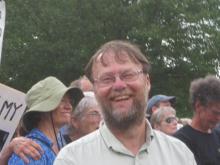At noon today I attended a seminar on the economics of town development. The speakers were sponsored by the town, county and chamber of commerce. The argument they presented was that most suburban development both residential and commercial require a very long time to pay back the costs of maintaining the initial infrastructure much less the general government cost of services. They analyzed the tax value/acre of land of various properties in town. Multiple store buildings create the greatest value although the Spotted Dog also was high in their calculations. Box stores like Walmart rated relatively low on their scale. Implied by their presentation is that the cost benefit formulas used for residential, commercial and industrial are misleading. By the way the title of their talk: Dollars and Sense is a name of a magazine I've subscribed to for years. It is edited by a "collective of economists, journalists and activists who are committed to social justice and economic democracy." www.dollarsandsense.org
Loren
Issues:



Comments
elected and candidate roll call for Noon version of this
I was there as well (tax base discussions certainly have school funding implications in this county), so was Mia Burroughs, recently Out of Africa.I saw Jim Ward and Ed Harrison from CH TC. And candidates Loren, Gary Khan and George Cianciolo. There may have been others at the 6pm version at Extraordinary Ventures - I had a couple of conflicts tonight and thus Noon was easier to take a "lunch break" from work.It was certainly an interesting presentation. One thing that wasn't emphasized but it made me consider is that infrastructure investments are much less in existing underutilized development rather than new (where we also lose trees). So you could consider adding same square footage at Ephesus Church or UMall as Obey Creek or Central West with a better ROI from the local govt perspective.The other shocking point was how little tax Walmart (in H'boro) brings in compared to Greenbridge. On a per acre basis, we're talking almost 100 times more for Greenbridge. There's some BANG for your buck! (and it did make me want to go to Spotted Dog to support the most expensive patch of land in Carrboro)
6 pm presentation
Turnout wasn't great for the 6 pm presentation, but that was great for me, as it made for a more intimate Q&A session. There were some folks in the crowd who weren't buying it; one gentleman, whose name I'm not sure of so I won't mention it here, loudly whispered at some point "numerology!", indicating his skepticism. Personally, I thought it was a solid presentation. The big point, I think, is that you can build X amount of roads and sewer to support low-density, single-family home infrastructure, or you can build just a slight amount more (wider pipes, marginally wider road) to support higher-density infrastructure. In the former case, the municipality's long-term maintenance costs for the infrastructure will outweigh the revenue growth that results the new development. In the latter case, the denser development will have much higher value and will allow the municipality to cover the costs of the infrastructure. Unfortunately, the former approach is what has been the typical pattern of development in post-WW II America, and many people still think that single-family homes on lots with lots of trees and paved roads that see little traffic is the most economically sustainable and envirionmentally friendly form of development.Charles Marohn, one of the presenters, runs Strong Towns, which is a wonderful site with some great resources about development. Marohn is a "reformed engineer" who also does a great job blistering roads and other infrastructure that blow out neighborhoods and ignore pedestrians. This is one of my favorites.Joe Minicozzi was the other presenter; another article about his work was published in The Atlantic Cities.
Reception
I wasn't able to stay for the 6 pm Q&A, but I too was confused about the reception of Charles' presentation by some in the audience. I have emailed the person who was most vocally skeptical. This was the kind of information many in the community have been wanting to discuss for several years. It accurately reflected the financial challenges to maintaining infrastructure cities and utilities are facing all around the country, including Chapel Hill. My only guess is that those who were scoffing didn't like it because it argues for taller buildings on smaller footprints.And finally we heard a consultant say that depending on sales tax as a way of justifying new development is just silly (the state takes over 70% of all sales tax revenues). Yes, there is revenue left over but building smarter and relying on small footprint retail/commercial makes more financial sense, per their theory. EF Shumacher (Small is Beautiful) was actually represented in a Chapel Hill development discussion! It was a day to remember.
the Smart Math
Here's an article the presenters wrote for those who were not able to attend:http://www.planetizen.com/node/53922
If you read no other part...
... then at least look at this comparison.